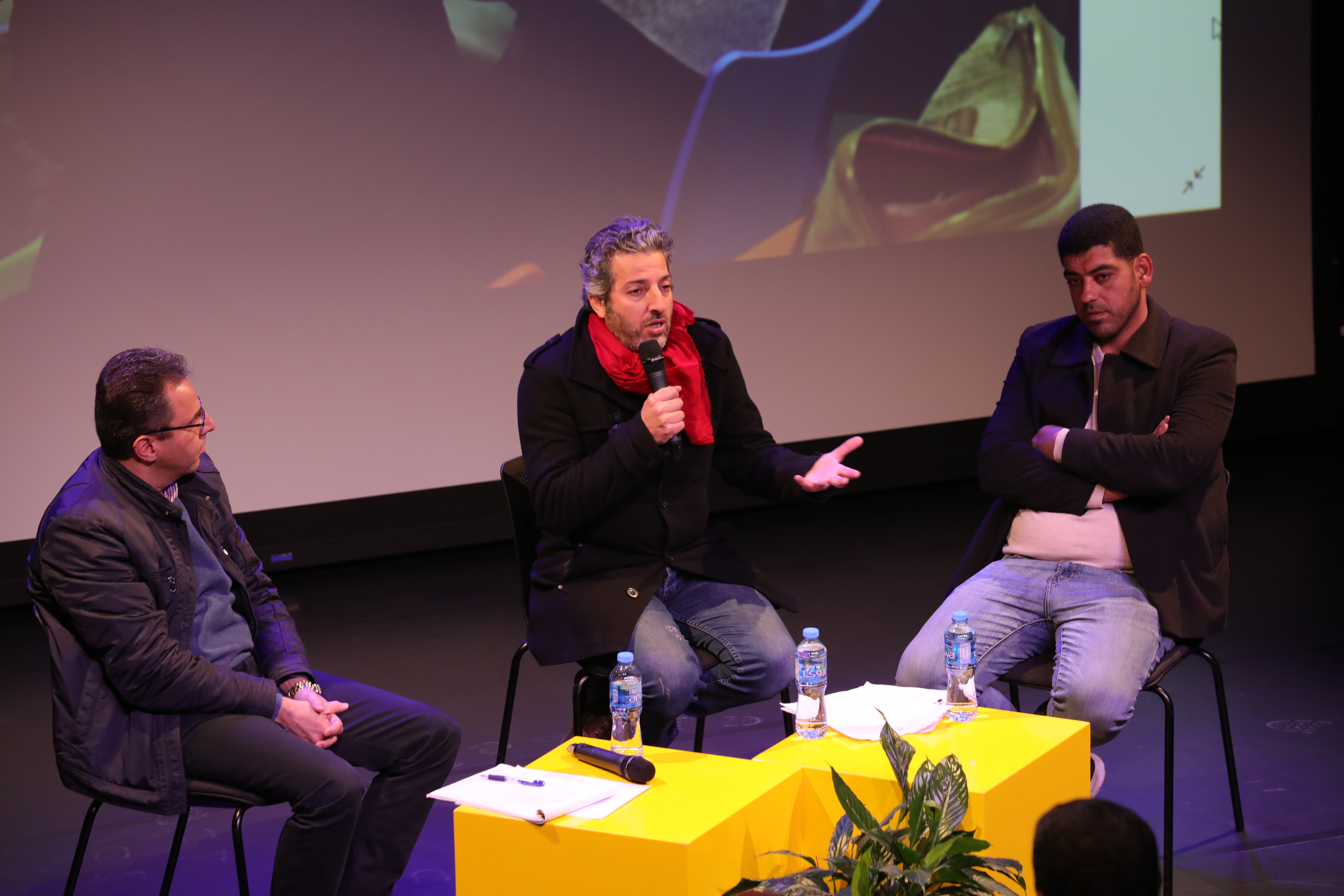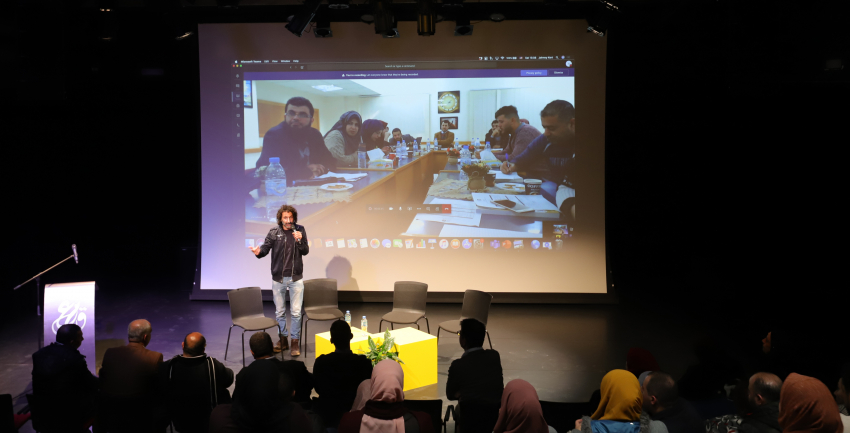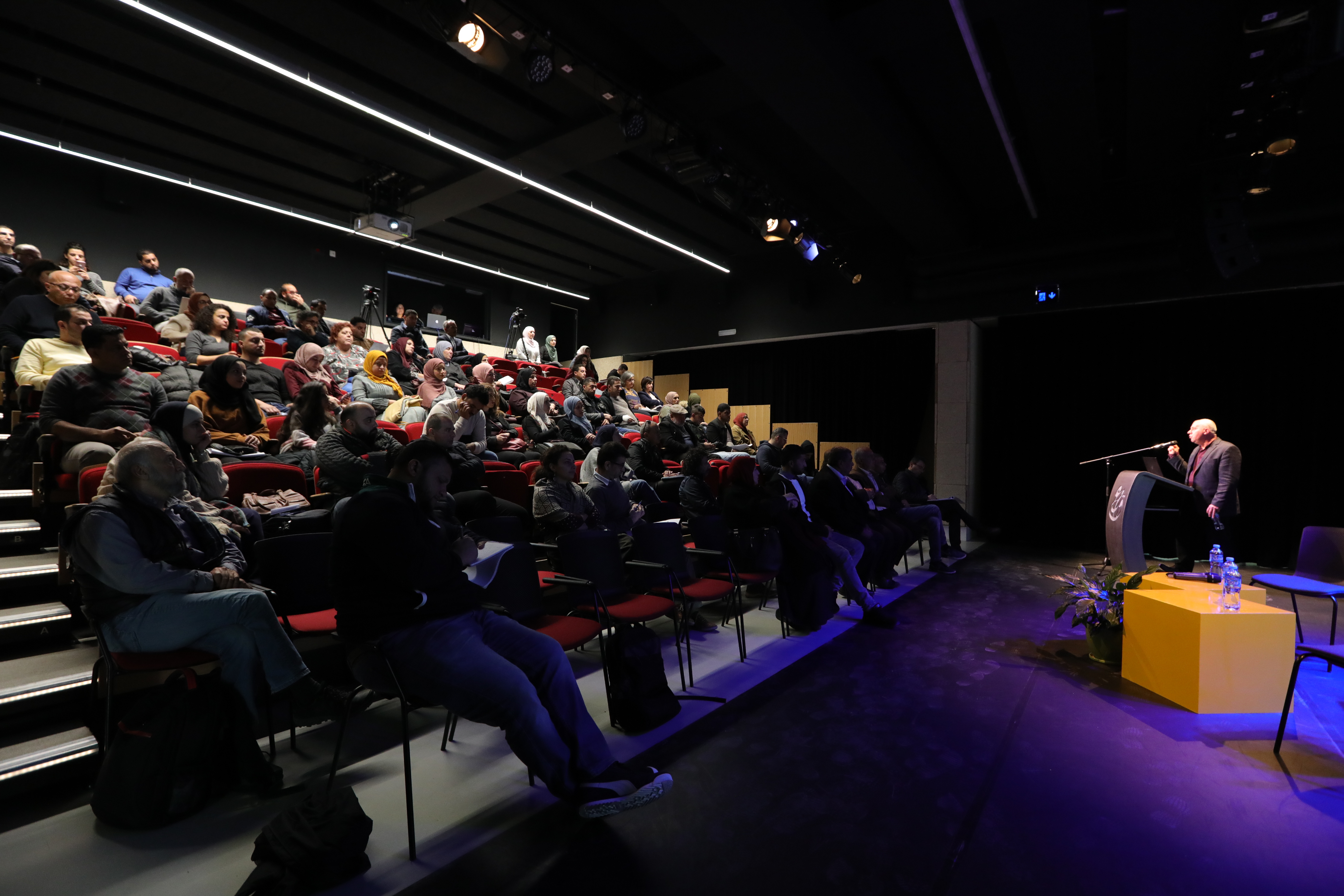

I have always heard that Jericho is a “cursed city that people must cross quickly and never reside in.” It never occurred to me how the sons and daughters of Jericho must have been feeling when hearing such sayings about their city, since they live in it and belong to it. This question came back to my mind when it was raised – along many stories – in a play called “Open the Suitcase.” The play was performed by boys and girls from the city, within the framework of the Culture, Art, and Social Engagement (CASE) Project; one of the projects of A. M. Qattan Foundation (AMQF), in partnership with the Swiss Agency for Development and Cooperation (SDC).
The project was implemented over the past four years (2016 – 2019) in several areas in the West Bank and the Gaza Strip: Ni’lin, Qatanna, Qalqilya, Jericho, the Abu Al-Nawwar Bedouin community, Deir El Ghusoun, Anabta, Hebron villages, Al-Jiftlik, Gaza, Beit Lahia, Abasan, Az-Zawayda, and Khan Yunis. It has managed to achieve a major artistic intervention in a society where art is still marginal, secondary, aesthetic, or perhaps considered a burden or a taboo, which was obvious in how the residents of many of these areas dealt and interacted with the researchers of the A. M. Qattan Foundation, particularly in Qatanna and Qalqilya, for instance, before the situation was completely reversed at the end of the four years. This can be clearly manifested in the outcomes of the project, such as “Open the Suitcase” play; which is only one example. The researchers spoke about all that during a Symposium that was hosted by the A. M. Qattan Foundation in Al-Tira, on Saturday, 14 December 2019.
In Jericho, boys and girls opened the suitcase of the untold reality through their play “Open the Suitcase”, which was performed twice on a stage in the city, and was met with so much admiration that can be seen in the warm applause and interaction that accompanied the performance. The heroin of the play; Raheeq Yamani, said that she felt the admiration of the people in the words of praise she heard from them.
TThe heroes and heroines of the play took out of their suitcase their own suffering as the residents; sons and daughters of Jericho; their own city which they no longer perceive as the agricultural and industrial city, as famously known, since they have no access to job opportunities, and the wages there are very low. Therefore, Raheeq had to work in a settlement where she then was subjected to harassment from the (Israeli) employer she worked for.
“Open the Suitcase” was followed by “Out of Control;” another play produced within the framework of the Culture, Art, and Social Engagement Project. Its main themes are modern technology and means of communication. It should be noted that during the making of the second play, six other boys and girls joined the first group, and they will continue their work after the A. M. Qattan Foundation has asked them to propose their own initiative in order to support them.
The crossing point in Jericho, which represents a gateway or an outlet for the Palestinians of the West Bank and sometimes the Gaza Strip so they can see the world, was not crucial or central in some of the stories presented in the play “Open the Suitcase”, whereas the checkpoint in Ni’lin; which is considered the Palestinians’ gateway to enter the Green Line zone, was central in many of the stories related to the village of Ni’lin. These stories were successfully collected in a 25-minute movie entitled “The Crossing Point” directed by Bassam Jarbawi. In Ni’lin, there is a checkpoint between the West Bank and the interior side of the Green Line called “the crossing point.” Because of it, the illegal vehicles have spread in Ni’lin, along with car markets and repair shops visited by Israeli settlers, in addition to the confrontations[1] that take place and the kiosks set up beside the checkpoint by the old and young men from Ni’lin to sell food and beverages to the workers and people who cross the checkpoint.
When the movie was screened in Ni’lin, and then in A. M. Qattan Foundation, it created intense debate about the changes taking place in Ni’lin, and the negative habits, that are incompatible with its people’s long-term struggles, that managed to sneak into their community.
The volunteers in Ni’lin also managed to sign a petition against using illegal vehicles in the village. It is one of the two parts of the artwork entitled “Under De-Registration” produced by the volunteers in Ni’lin, and the other part of the artwork is a mirror that was installed out of assembled vehicle plates.
What is remarkable about this village is the huge number and diversity of the project’s outputs, starting with the restoration of memory in “The Road of Echo” which drove people to retrieve their memories with the one and only bus of Ni’lin in the last century, to the freedoms that the occupation robbed and were discussed in “The Crossing Point” film, and the society and its traditions discussed in the short film “A Girl with a Bicycle”. The film presents the story of a girl who is denied the right to ride her bicycle on the street, and is only allowed to ride it on the limited-size roof of her house, risking her life.
Among the remarkable outputs of Ni’lin also was a project named “Windows for the Roof,” in which the prisons were transferred to Ni’lin, and Ni’lin was transferred to the prisons. In occupation prisons, beds are placed on top of each other, so each bed has a ceiling/roof in which the prisoner has photos of their loved ones. For this project, the volunteers took photos that the prisoners asked for and had sent to them. They also placed beds the same way they are in the occupation prisons. People flowed to live the experience of the prisoners and evoke their feelings.
Since the crossing point is essential in the stories of Jericho and Ni’lin, the sea is the main theme/ story in Az-Zawayda village in the centre of the Gaza Strip, which embraced a campaign called “The Sea is Ours” with a lot of creativity embodied by 30 young men and women who are mainly artists in the fields of drama, singing, and painting. They were able to achieve an intervention that motivated the mayor of Az-Zawayda village and his staff members to attend the Storyteller show that was presented by two female artists wearing the Palestinian traditional dress. The show included some singing in an area that never accepted the appearance of a woman on stage, or the performance of a mixed team, according to Ali Mohanna; the coordinator of the project, artist, and director.
In the project “The Sea is Ours,” the team managed to change the children’s and residents’ perception that the sea only belongs to the municipality or to the occupation, and replaced it with the notion “the sea belongs to us”. Since then everyone has set out to clean the beach driven by the fact that the beautiful and clean sea, that gives us goodness, must have a clean beach. Moreover, this area is mine, just like my own shirt; which I don’t like getting dirty or torn and must be preserved.
Within two weeks, the team managed to build a special site that, for months, turned into a tourist destination for the people of the region who described it as comfortable and enjoyable, as it also became the headquarters of the team’s activities and theatrical and musical performances, in addition to the storyteller show, along with the sailor [Al-Mubaharati] show which was created, by the team itself, similar to [Al-Musaharati][2], but with words related to the sea.
Here was the second intervention achieved by the team when the Municipality of Az-Zawayda gave them the beach for free to establish their site and implement their activities in it. Their site was built from palm trunks and fronds. They built a canopy for the audience to sit under the shade, and also installed benches made from palm trunks.
The mission in Jericho, Ni’lin, and perhaps Az-Zawayda village was easier than it was in Qalqilya; which had three references when deciding to work in it. Then before the end of the project, art became its fourth reference, according to Malik Rimawi; the senior researcher in the “Teachers Professional Development” program in A. M. Qattan Foundation.
The difficulty in this project was not only in the introduction of art, but also in discussions such as the liberation of women, starting with investigating the reasons behind banning a woman’s name from being written on her wedding invitation card, up to reaching the point where the woman takes the chains and constraints off, and believes the fact that she is, by all means, half of the society.
Artists and volunteers in the CASE Project – Qalqilya produced an exhibition in which visitors wrote the names of their mothers, sisters, daughters, and wives with additional sentences. The result was that they wrote their names with so much pride.
According to Rimawi, the strength of CASE Project lies in the partnership relation created between the researchers and volunteers and people in the target areas. He says that people tend to repeat the common social discourse when talking to them and raising questions. But in order to be truthful, and for them not to treat us as strangers, we should treat people as partners. If that does not happen, they will treat us as strangers, and put us in certain molds.
This partnership had an impact on people and artists, too. This was confirmed by Munther Jawabreh (artist) in his talk about Qatanna after he participated with the people there in painting and producing beauty. According to Jawabreh, these people closed their doors at the beginning of the project, then after four days, and when they saw the beautiful art and paintings, the whole atmosphere changed and they started to participate not only in work, but also in making tea and preparing food, as well as opening their homes for the participants. This was also confirmed by researcher Yasmin Qaoud in her own understanding of the CASE project and its outcomes, as she referred to the fact that the people who had shut their doors in the beginning were the same ones who hung notes asking visitors not to sabotage the paintings.
In Deir El Ghusoun, work began at the same time when the municipality had decided to demolish a historical building called “Akd Al Badd” (a very old oil press house historically linked to Ahmad Pasha Al-Jazzar) in order to use the space to make parking lots. So, action was taken in order to suspend this decision. And this is what was done after gathering signatures from the residents of that area demanding that the demolition be stopped.
Activists along with the residents of Deir El Ghusoun were able to suspend the demolition order. They created a mobilization of society and a collective awareness around the necessity of protecting and reviving historical places, by using them for the public interest. As a result, “Akd Al Badd” building was renovated, and became a major tourist destination in Deir El Ghusoun. It is also used for social and cultural events.
Inspired by the experience of “Akd Al Badd,” some families from Deir El Ghusoun have dedicated four historic houses to become community venues and incubators of culture and art. One of which was turned later into a community cultural centre. The residents also offered six abandoned and neglected houses in a remote area close to the Massin Valley. The project team, volunteers, and residents visited the area every Friday and cleaned it of all the plastic waste and dry trees. So the area that used to be a forest was transformed into a wildlife museum.
The volunteers brought to the area (museum) wooden benches and synthetic artworks made of wood and stone. They also built a large wooden gate, reclaimed the water well, and put names of wild plants on signs, until the area became a permanent destination that families visit especially on Fridays. Residents of Deir El Ghusoun consider this place the most important for recreation.
The CASE Project has won the approval of the SDC to renew the funding for another four years (2020 – 2023). In the coming stage, the project will work to build on is previous achievements, in addition to placing the available energy in the hands of school teachers and students to work through them.
It is worth mentioning that Mrs. Ragheda Andoni; Program Manager at the Swiss Cooperation Office - Gaza and West Bank, emphasized that, in addition to enhancing social participation and accountability, the goal of the project is to empower communities to become agents of change which leads to sustainability. “We aspire to have an effective society, each one in their position; we have planted the first seed to create interaction and encourage mobilization so that people themselves can lead change.”
[1] Such confrontations (or encounters) usually take place between the Palestinians and the Israeli soldiers at the checkpoint. (Translator).
[2] The “suhoor” caller; or dawn awakener is the person who beats his drum just before dawn to wake people for “suhoor” in Ramadan. (Translator).

